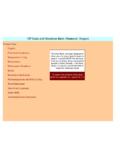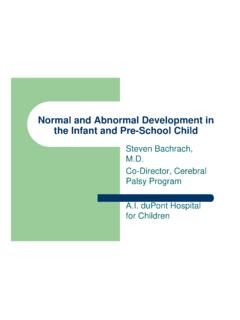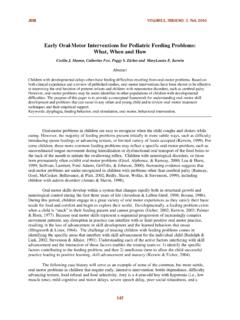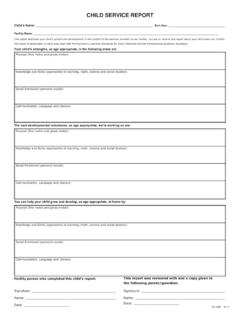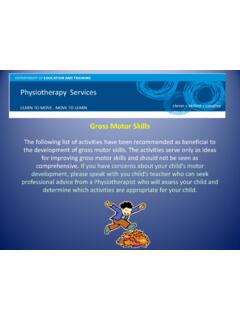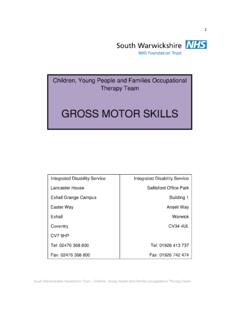Transcription of NHANES National Youth Fitness Survey (NYFS) Test of Gross ...
1 National Youth Fitness Survey (NYFS) Test of Gross motor Development (TGMD-2) Procedures Manual April 2012 -iii- Table of Contents Chapter Page 1 Overview of The Gross motor Development (TGMD-2) .. 1-1 Background .. 1-1 Key Elements .. 1-2 2 Equipment, Supplies and Set-up .. 2-1 Test Elements .. 2-1 Supplies .. 2-2 3 Examination 3-1 Eligibility .. 3-1 Examination 3-1 Administration 3-1 Examination Procedures .. 3-2 Scoring Directions .. 3-10 Report of Findings .. 3-10 4 Integrated Survey Information System (ISIS) Data Entry .. 4-1 General Screen Information .. 4-1 Recording the Results .. 4-3 skills Test Status .. 4-4 Post-Exam Procedures .. 4-6 Component Status .. 4-6 Procedures for Conducting TGMD-2 Gold Standard Exams .. 4-8 Comparing the Exam 4-11 5 References .. 5-1 -iv- Table of Contents (Continued) List of Tables Table Page 4-1 Comment Code descriptions.
2 4-7 List of Exhibits Exhibit 2-1 Equipment and space requirements for TGMD-2 .. 2-1 2-2 Ball bag with equipment .. 2-2 3-1 Description of the six locomotor subtests .. 3-4 3-2 Description of the six object control subtests .. 3-7 4-1 Logon SP screen .. 4-1 4-2 Screen showing skill tabs for TGMD .. 4-2 4-3 Completed screen for run skill .. 4-3 4-4 Status of tests as shown by checks on skill tabs .. 4-4 4-5 TGMD tab results screen .. 4-5 4-6 TGMD tab results screen showing final status of tested skills .. 4-6 4-7 Screen for partial or not done exams .. 4-8 4-8 Initial Gold Standard 4-9 4-9 Selecting names for Gold Standard .. 4-10 1-1 1. OVERVIEW OF THE TEST OF Gross motor DEVELOPMENT (TGMD-2) Background* Gross motor skills involve the large muscles of the body that enable major body movement such as walking, maintaining balance, coordination, jumping, and reaching. Gross motor skills depend on both muscle tone and strength.
3 Children with better-developed motor skills may find it easier to be active and engage in more physical activity than those with less-developed motor skills . Children with poorer motor skill performance have been found to be less active than children with better-developed motor skills1. The relationship between motor skill performance and physical activity may be important to the health of children, particularly in obesity prevention. Locomotor skills are those that require fluid movements of the body as the child moves in one direction or the other. Object control skills are those that demonstrate efficient throwing, striking, and catching movements. By age 3, most children can go up and down stairs by alternating their feet, jump in place, and throw overhand. By age 4, most children can catch a bounced ball, jump with a running start, and pedal a tricycle. By age 5, most children can gallop, leading with one foot, roll like a log, and propel themselves on a swing.
4 The Test of Gross motor Development Second Edition (TGMD-2) ( com/ ) will be used to test the motor skills of all 3-5-year-olds participating in the National Youth Fitness Survey (NYFS). The TGMD-2 is a norm-referenced measure of common Gross motor skills that develop early in life. It has been used by researchers in several countries2-9 and combines fun activities with a procedure that is valid and reliable. The TGMD-2 is composed of two subtests for Gross motor development Locomotor and Object Control both of which have six skills that assess a different aspect of Gross motor development. Locomotor: run, gallop, hop, leap, horizontal jump, slide. Object Control: striking a stationary ball, stationary dribble, kick, catch, overhand throw, and underhand roll. * List of references is included in Chapter 5.
5 1-2 Each Gross motor skill includes several behavioral components that are presented as performance criteria. For example, performance criteria for the run are (1) arms move in opposition to legs, elbows bent; (2) brief period where both feet are off the ground; (3) narrow foot placement landing on heel or toe ( , not flat-footed); and (4) nonsupport leg bent approximately at 90 degrees ( , close to buttocks). If the child performs a performance criterion correctly, the examiner will record a 1. If the child does not perform a performance criterion correctly, the examiner will record a 0. Partial scores to show that the child displays the criterion, but is inconsistent, are not allowed. If the SP refuses to perform the skill, he or she is coded as Did Not Participate. Key Elements TGMD-2 Ages 3 5 years Eligibility 3 5 years; consented SPs Exclusions Physical limitations requiring a wheelchair; amputations of the leg, foot, arm, or hand; paralysis of one or both arms or hands; hand/arm/shoulder/leg surgery in last 3 months; mental impairment Risks Slight risk of sprain or strain to leg or ankle Equipment TGMD-2 kit, including Examiner s Manual 8 -10 playground ball, two 4 plastic balls, three tennis balls, 4 -5 beanbag, soccer ball, two traffic cones, plastic bat, two Nerf balls, batting tee, electrical type tape, ball bag (for storage) Time Allotment 15-20 minutes Report of Findings No ROF is provided 2-1 2.
6 EQUIPMENT, SUPPLIES AND SET-UP Test Elements The following table lists the equipment, including space, needed for each of the skills tested. The space that is required has been modified from the original test in order that it can be conducted in the mobile center (MC). Exhibit 2-1. Equipment and space requirements for TGMD-2 Skill Minimum space or line required 8 -10 plastic playground or soccer ball 4 plastic ball Tennis ball 4 -5 beanbag 2 traffic cones/tape Plastic bat Nerf ball Batting tee Run 28 X Gallop 16 X or tape Leap 14 X Horizontal jump 10 X Slide 10-15 X Striking stationary ball X X X Stationary dribble 15 sq ft area X Catch 10 X Kick 10-15 X X Overhand throw 10-15 X Underhand roll 10-15 X A strip of brightly colored electrical tape is applied to the floor, extending from the curtain door of Exam Room 1 to a foot out from the back wall for visual direction.
7 The activities that require a straight line, such as the slide and gallop, are performed along this strip of tape. Another strip of tape crosses the long strip 10 feet out from the back wall. The intersection of the tape is a visual clue for skills like the jump. The beanbag used for the leap is also placed on the junction of the tape. The back wall has been covered with 4 feet of padding from the floor up to prevent injuries and damage to walls. 2-2 Supplies Mild, all purpose cleaner and clean cloths or disinfectant wipes for wiping down the equipment. The balls and the handle of the bat used by the SP should be wiped before each use. Assorted colors of poly spots (round vinyl instructor spot markers). Ball bag to hang equipment on wall. Exhibit 2-2. Ball bag with equipment 3-1 3. EXAMINATION PROTOCOL Eligibility All sample persons (SPs) aged 3 5 are eligible for the TGMD-2. The parent s answers to questions that are administered through the Nurse Review will exclude SPs who have had a recent injury, surgery, or other disability that could inhibit or prevent their performance.
8 If the SP is ineligible, the SP will not be listed in the TGMD-2 application on the computer. Examination Conditions Test conditions should be arranged prior to beginning the test to help minimize administration time and distractions. All materials needed for testing should be readily available. Gather the balls for the striking, catching, kicking, and throwing skills to minimize time spent on ball retrieval. Wipe the balls and the handle of the bat with a disinfectant cloth to prevent the spread of germs. Place the equipment needed for each skill in the ball bag hung on the wall. SPs should wear rubber-soled shoes to minimize the chance of slipping and falling, and to promote maximum effort in performing the locomotor skills . Shoes and socks are provided on the MC if needed. Testing time will vary with the child s abilities, but the entire TGMD-2 can be given in approximately 15 to 20 minutes.
9 Administration Procedures Standardized procedures must be followed in order to compare a child s scores to those made by peers in the normative sample. The following requirements are standard for administering the tests most reliably in an attempt to minimize any discriminatory practices by ensuring that the SP understands the examiner s directions. 3-2 1. Give an accurate demonstration and verbal description of the skill to the SP prior to allowing the SP to perform it. 2. Provide a practice trial to ensure that the child understands what to do. 3. Provide an additional demonstration when the child does not appear to understand the task. 4. Administer two test trials and score each performance criterion on each trial. The examiner has responsibility for controlling or accounting for the obvious variables that can adversely affect the SP s performance ( , improper clothing or footwear, amount of space needed, no rest breaks).
10 You should encourage the SP but avoid prompting or otherwise deviating from testing procedures. You may use language such as Very good! and That s great! and You re doing a great job! Remarks such as Throw hard or Jump as far as you can also are appropriate. However, comments that appear to reflect on the level of the SP s ability, such as That s right should not be used during test administration. To achieve a valid interpretation of an SP s TGMD-2 performance, the scales must be administered exactly as specified in the following sections taken from the TGMD-2 Examiner s Manual. Each section provides the examiner with the name of the skill, materials needed, directions for administration, performance criteria, an illustration of the skill tested and a script to use when describing the exercise to the SP (Exhibits 3-1 and 3-2). The Integrated Survey Information System (ISIS) is designed so that the skills can be administered in any order.










